Okay, I’ll admit it, I’m a full on technology addict. I love anything new and “techy” and thankfully, I get to play with a bunch of cool new stuff as part of doing my job. This time I’m going 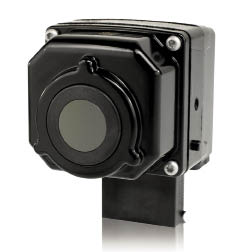 to tell you about a hot new product that has yet to become really popular in the aftermarket world of performance and mobile electronics. It’s just so damned cool and makes so much sense, that I think it will catch on soon. What I’m talking about isn’t something to make your car faster, or sound better, in fact it has really nothing to do with performance or sound, and everything to do with safety. Now before you tune out and flip the page, hang on a second…
to tell you about a hot new product that has yet to become really popular in the aftermarket world of performance and mobile electronics. It’s just so damned cool and makes so much sense, that I think it will catch on soon. What I’m talking about isn’t something to make your car faster, or sound better, in fact it has really nothing to do with performance or sound, and everything to do with safety. Now before you tune out and flip the page, hang on a second…
 to tell you about a hot new product that has yet to become really popular in the aftermarket world of performance and mobile electronics. It’s just so damned cool and makes so much sense, that I think it will catch on soon. What I’m talking about isn’t something to make your car faster, or sound better, in fact it has really nothing to do with performance or sound, and everything to do with safety. Now before you tune out and flip the page, hang on a second…
to tell you about a hot new product that has yet to become really popular in the aftermarket world of performance and mobile electronics. It’s just so damned cool and makes so much sense, that I think it will catch on soon. What I’m talking about isn’t something to make your car faster, or sound better, in fact it has really nothing to do with performance or sound, and everything to do with safety. Now before you tune out and flip the page, hang on a second…
Have you ever watched any of those war movies or cop shows on TV where a helicopter or plane is equipped with night vision, and the bad guys have nowhere to hide? Well hold on to your shift knob, because the exact same techno-dazzle is now available for your custom ride. Yup, you can have your very own FLIR (Forward Looking InfraRed) night vision system, right there in your dash and you don’t need to fly an AH-64A/D Apache Longbow attack helo to get one!
I’m talking about the PathfindIR system from FLIR Systems Inc. For those of you unfamiliar with FLIR night vision systems, the concept of making images with heat is not new. In about 1800, Sir William Herschel (Royal Astronomer to King George III) accidentally discovered the infrared spectrum while searching for an optical filter to reduce the brightness of the sun’s image in telescopes. Over the years, much experimentation ensued and forty years later, as a result of work done by Sir John Herschel (the son of Sir William) the first “heat-picture” became possible. To understand how we can see heat energy, we must take a quick look at what scientists call “The Electromagnetic Spectrum”
Infrared energy is only a small part of a complete range of radiation called the electromagnetic spectrum. This spectrum is made up of gamma rays, X-rays, ultraviolet light, visible light, infrared, microwaves (RADAR) and radio waves. The only difference between all these various types of waves is their wavelength, or frequency. All of the different types travel at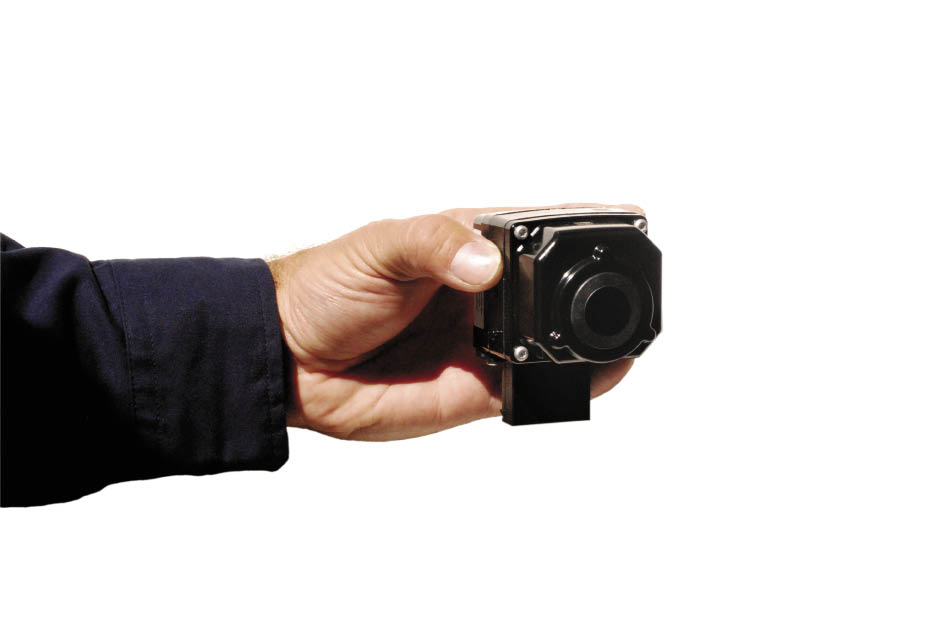 the same speed, which is the speed of light, or approximately 186,000 miles per second in a vacuum like space.
the same speed, which is the speed of light, or approximately 186,000 miles per second in a vacuum like space.
Infrared radiation makes up a much greater percentage of the spectrum than visible light, and has wavelengths longer than visible light, but shorter than radar waves. The primary source of infrared radiation is heat. Any object that has a measurable temperature emits infrared radiation. Even very cold objects, like an ice cube, still emit infrared energy. Infrared cameras produce an image of invisible infrared or “heat radiation” unseen by the human eye.
There are no colors or shades of gray in infrared, only varying intensities of radiated energy. The infrared imager converts this heat energy into an image with contrasting shades of gray that we can make sense of. The process is properly described as “thermal imaging”, and instead of using visible light to allow us to see, the thermal imager uses nothing but infrared radiation to create images that look sort of like black and white pictures. The contrast in the image is created by the differences in temperature of the objects in the image. With a thermal imager, warm things appear as light gray to white, and cooler objects are darker to black.
There are a few different kinds of these technologies available, but true thermal images such as this FLIR system should not be confused with infrared “illuminator” cameras. These cameras do not produce the same images, because they do not detect heat. They operate in wavelengths near visible and require an IR “illuminator” to provide an image. These cameras are very economical, but seldom have range beyond about five meters, making them useless for most vehicle applications.
Infrared energy is only a small part of a complete range of radiation called the electromagnetic spectrum. This spectrum is made up of gamma rays, X-rays, ultraviolet light, visible light, infrared, microwaves (RADAR) and radio waves. The only difference between all these various types of waves is their wavelength, or frequency. All of the different types travel at
 the same speed, which is the speed of light, or approximately 186,000 miles per second in a vacuum like space.
the same speed, which is the speed of light, or approximately 186,000 miles per second in a vacuum like space. Infrared radiation makes up a much greater percentage of the spectrum than visible light, and has wavelengths longer than visible light, but shorter than radar waves. The primary source of infrared radiation is heat. Any object that has a measurable temperature emits infrared radiation. Even very cold objects, like an ice cube, still emit infrared energy. Infrared cameras produce an image of invisible infrared or “heat radiation” unseen by the human eye.
There are no colors or shades of gray in infrared, only varying intensities of radiated energy. The infrared imager converts this heat energy into an image with contrasting shades of gray that we can make sense of. The process is properly described as “thermal imaging”, and instead of using visible light to allow us to see, the thermal imager uses nothing but infrared radiation to create images that look sort of like black and white pictures. The contrast in the image is created by the differences in temperature of the objects in the image. With a thermal imager, warm things appear as light gray to white, and cooler objects are darker to black.
There are a few different kinds of these technologies available, but true thermal images such as this FLIR system should not be confused with infrared “illuminator” cameras. These cameras do not produce the same images, because they do not detect heat. They operate in wavelengths near visible and require an IR “illuminator” to provide an image. These cameras are very economical, but seldom have range beyond about five meters, making them useless for most vehicle applications.
Okay, enough of the science class, lets talk about the gear I have in my hands. The FLIR Systems company sent me one of their complete Pathfinder IR systems, which includes basically everything you need to install “night vision” in any vehicle. The system primarily consists of a special IR camera, and a 7-inch black and white LCD monitor. A twenty foot long wiring harness and all mounting brackets are also included, as well as a rather industrial looking “sunshade” for the monitor. The system proved very easy to install, as all you have to do is give the IR camera an unobstructed view of the road ahead. And by unobstructed, I mean the camera has to be mounted outside the vehicle, as the camera obviously can’t sense heat through a windshield. FLIR suggests mounting the camera in an open area under a bumper or grille area, basically anywhere the camera lens can get an clear look at the road ahead. The camera itself is pretty small, measuring about 2.3 inches square, making it pretty simple to find a spot for it on most vehicles, and it’s solid for its size, weighing in at just under a pound. The weight is no surprise, due to its robust materials and sturdy packaging. Plus inside the camera is a bunch of impressive technology, including a shutter with automated image calibration protocol that runs every few minutes and an internal heating element to stabilize the camera at low temperatures.
The entire system is plug and play simple, and only requires a B+ and a ground connection to operate. A power switch on the monitor allows you to turn the system on and off manually as well. The system draws very little current, and has a 5 amp fuse to protect itself. I mounted it in my truck, and over the course of a month or so, made a bunch of night drives on local back roads. The camera automatically adjusts to changing conditions, so no additional camera control or adjustments are needed. The contrast of images was automatically optimized as I drove, providing me with excellent clarity at all times. The system proved dead simple to use, and took almost no time to completely get used to relying on it to help me see at night, even when there were streetlights and such… Animals and children on the sidewalk were evident much sooner than normal, and I couldn’t believe what an improvement in situational awareness the system brought. The difference in my ability to see the road and various objects in front of me was stunning. Even with my quartz halogen headlights on high beam, I could see much farther ahead with the Pathfinder system. Animals, people and parked cars were easy to spot hundreds of feet sooner than I would have seen with my headlights.
The deer in the photo below gives you an idea of how dramatic the difference is. You can even see the upcoming turn in the road, long before the headlights illuminate it. In the second set of photos, notice the heat under the passing car, and of the car parked way ahead that I can’t see with my lights. No doubt about it…this thing is way cool.
These devices are currently being used for all sorts of applications including firefighting, security, maritime and industrial applications. The most popularly known use is by the military to navigate at night and in battlefield conditions.
Over the last few years, the sheer volume produced of these systems has allowed the cost to come down, and make the systems viable for the commercial market. As tested the price of the PathfindIR system was still significant, at about $3,250USD for the full kit, monitor, camera, etc. which we tested. However, if you already have an acceptable monitor of 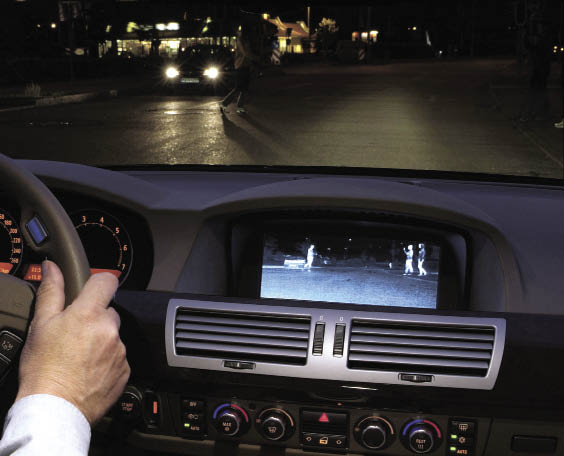 some sort, like an aftermarket head unit with screen, FLIR suggests you only need to get the a camera and cable which sells for $2,750USD.
some sort, like an aftermarket head unit with screen, FLIR suggests you only need to get the a camera and cable which sells for $2,750USD.
 some sort, like an aftermarket head unit with screen, FLIR suggests you only need to get the a camera and cable which sells for $2,750USD.
some sort, like an aftermarket head unit with screen, FLIR suggests you only need to get the a camera and cable which sells for $2,750USD.But given that the systems produced just a few years ago went for many times that amount, the cost is dropping significantly, and it’s now to the point where people who do a lot of night, or low visibility driving such as in fog, dust, or storms, can easily justify the cost. It will only take one accident avoided to more than pay for itself. And lest you think this high tech gadgetry is still military interest only stuff, take note Cadillac offered it between 2000-2005. While GM has since dropped the option, it’s currently available at the dealership level as an aftermarket kit on Hummers. High end techno-leaders like Mercedes S Class and BMW 7 series also currently have similar system options. The BMW solution (available since 2006) uses a FLIR thermal core, and the Mercedes uses a completely different infrared illuminator (that doesn’t sense heat), and is similar to the “Night Shot” feature in consumer camcorders.
BMW has offered FLIR night vision since 2006, and currently offers FLIR’s thermal technology coupled with pedestrian detection in their 2009 BMW 7 series. It automatically alerts the driver to hazards approaching the road. Honda is also working on a similar night vision system for Japan market cars, and I believe in a few years, more cars will come with the thermal technology because it makes driving at night so much safer. Eventually it could be as commonplace as the radio, simply because it makes so much sense. If you frequently drive at night, or in low visibility conditions, you should really consider checking this new high tech system out. With several dealers around the country and around the world, the systems are not difficult to purchase or use. See some cool videos of this system in action and learn more at www.flir.com
BMW has offered FLIR night vision since 2006, and currently offers FLIR’s thermal technology coupled with pedestrian detection in their 2009 BMW 7 series. It automatically alerts the driver to hazards approaching the road. Honda is also working on a similar night vision system for Japan market cars, and I believe in a few years, more cars will come with the thermal technology because it makes driving at night so much safer. Eventually it could be as commonplace as the radio, simply because it makes so much sense. If you frequently drive at night, or in low visibility conditions, you should really consider checking this new high tech system out. With several dealers around the country and around the world, the systems are not difficult to purchase or use. See some cool videos of this system in action and learn more at www.flir.com
Related Articles
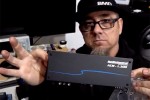 Steve Meade Unboxes, Plays and Dyno Tests the AudioControl ACM Micro Amplifiers
Steve Meade Unboxes, Plays and Dyno Tests the AudioControl ACM Micro Amplifiers
Steve Meade of West Coast Car Audio is seen in this video unboxing, playing and dyno testing the micro AudioControl ACM 1.300 mirco amplifier...
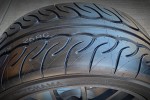 Yokohama Advan Neova AD08R Tire Review
Yokohama Advan Neova AD08R Tire Review
I attended an SCCA Track Night In America event at Portland International Raceway and had a chance to test out a set of Yokohama Advan Neova...
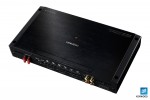 Kenwood XR600-6DSP Amplifier Review
Kenwood XR600-6DSP Amplifier Review
Anyone who has ever attempted to upgrade a factory audio system with some real power knows the challenges involved.
Depending on the specific car,...
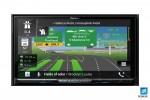 Pioneer AVIC-8400 NEX DVD/NAV Receiver Review
Pioneer AVIC-8400 NEX DVD/NAV Receiver Review
Ah, technology.
While it’s a struggle to simply keep abreast of all the latest and greatest advancements, there’s no argument that technology is a...
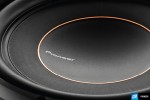 Pioneer TS-D12D2 12” Subwoofer Review
Pioneer TS-D12D2 12” Subwoofer Review
If you’re serious about pounding out bass, then you already know you want a no-compromise, truly high-performance subwoofer that can handle the...
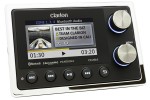 Clarion CMS4 Multi-Zone Marine Receiver Review
Clarion CMS4 Multi-Zone Marine Receiver Review
For our readers who enjoy spending some quality time on the water or find solace trekking through sand dunes in their powersports vehicles, we’re...




